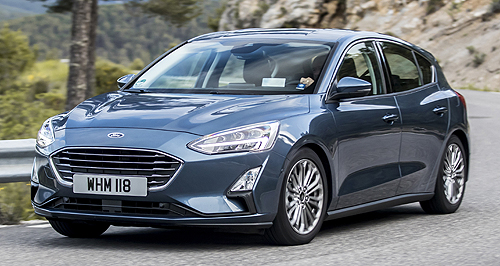News - Ford - FocusWhy most Ford Focus models ditch IRSFocus on driving: Entry-level versions of the Focus hatch will use a new torsion beam rear suspension setup. Only reputation kept torsion beam from taking over completely in new Ford Focus24 Jul 2018 By BYRON MATHIOUDAKIS in FRANCE FORD says the torsion beam rear suspension developed for entry-level and mainstream versions of the new-generation Focus provides handling, ride and refinement capabilities that are better suited to the majority of buyers than the multi-link setup found in the outgoing model.
The new setup also delivers lower material costs for improved profitability as well as easier packaging possibilities for future hybrid derivations.
However, an all-new multi-link system (known as the Short-Long Arm, or SLA) independent rear suspension was also co-developed simultaneously on higher-grade Focus variants as well as all wagon versions, for buyers that see the setup as superior.
According to Ford C2 architecture chief engineer Michael Blischke, the risk of dropping IRS altogether could cost the Focus in excess of a million sales over its lifecycle – especially in Europe where the Focus’ reputation for segment-best dynamic is ingrained with the product, as well as China where consumers demand the latest in technological advancement.
“The reason why we have two suspensions is simply that Ford in general and the Focus particularly has such a strong anchoring in dynamics,” he told GoAuto at the global launch of the fourth-generation series in France last week.
“And although the twist beam would actually suit 95 per cent of the population, there are certain markets where they don’t care what you have to offer, they just want SLA. China is such a market. Customers in China would lie underneath and look at the technology because they want the latest technologies. And they don’t really care about what we have to offer. We are very sensitive for what the customer wants.
“When we said we wanted to go twist beam, do we meet the expectations of the broader markets? And 80 per cent of the markets there is no debate; but 20 per cent of the market – which is significant volume, we’re talking about a million units of production – it becomes a point.”
While final Focus details and specifications will not be divulged until next month, GoAuto understands that the Trend, ST-Line and Titanium hatches arriving this November will all be fitted with the torsion beam for Australia, leaving only the ST-Line wagon with SLA/IRS.
Mr Blischeke said that the decision was made immediately to pursue both suspension designs for the Mk4 Focus, given the all-new C2 architecture was designed from the outset for modularity for ‘endless possibilities’.
“So, we developed basically a compatible system, which is standard twist beam and SLA,” he explained. “And both have common rails and common pick-up points, and common hard attachment points, so it becomes very compatible from a body-in-white perspective. It was a parallel development.”
Mr Blischke said that the torsion beam would not have met Ford’s internal dynamic targets if it was not for strides his engineers have made in making the C2 base significantly stronger, yet lighter than the previous platform. He said breakthroughs in component technologies also helped.
“Once we had that (suspension) discussion going, one of the other requirements was that, well, if we were going to go the path of twist beam, it needs to be and must be the world’s best twist beam,” he said.
“And I believe with the force vectoring technology, we have also proven that we have the world’s best twist beam.”
First seen in the upcoming Fiesta ST hot hatch, the force vectoring technology centres around springs that “apply vectoring forces to the rear suspension, enabling cornering forces to travel directly into the spring for increased lateral stiffness”.
Mr Blischeke admitted that some experienced drivers might still find limitations in the torsion beam setup compared to the IRS, but only in extreme circumstances.
“There is a little bit of difference,” he said. “If you are a true professional, and drive the vehicle hard through cornering, you would potentially feel a little bit different behaviour force input to the body between and SLA and twist beam; but you’re talking about the small percentage of individuals who actually can do that. I don’t think that is for the broader customers.”
To help ensure Ford was on the right track with its torsion beam development, two notable European competitors were studied and, according to Mr Blischke, improved upon with the help of the flexibility and advancements incorporated into the C2 architecture.
“We always do the benchmarking work – we would be foolish not to – and we always compare to the best to make sure we understand their technology and we take that a step further.
“We had the Peugeot 308 and Volkswagen Golf as part of our benchmarks, as part of the top-notch vehicles which we knew; we tried to understand what the kinematics of their suspension are and their weight distributions, and we tried to improve from there. And through our force vectoring system, where at corners you already get a more straightforward input load into the vehicles, you can tune the rest of your suspensions with a little more effect, as part of the system development.
“As part of the new development, and not having an old platform to work from, we could actually bring the centre of gravity to the lowest levels, so the floor is actually equal to ground clearance requirements, and we set the floor as deep as we could and match your chassis and suspension in line with that. That is the luxury if you have a new development… and that’s why you get this enormous planted feel when you drive and corner in the new Focus.”  Read more |
Click to shareFord articlesResearch Ford Focus pricing
Motor industry news |

















Facebook Twitter Instagram